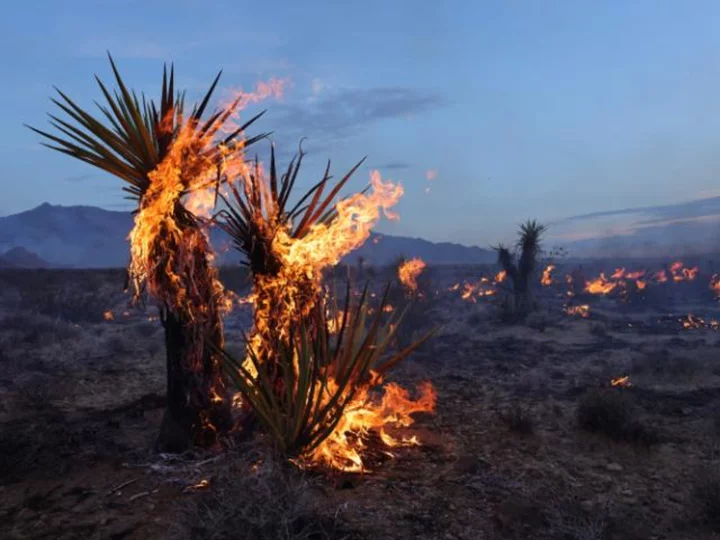Firefighters battling a large whirl-spawning wildfire in California and southern Nevada are facing challenging conditions as the blaze spreads and threatens iconic desert Joshua trees.
The York Fire -- already California's largest fire of the year -- has burned more than 80,000 acres as of Tuesday morning, fire officials said. It began Friday in the New York Mountains of California's Mojave National Preserve and crossed state lines into Nevada on Sunday.
Crews have been battling the flames under unpredictable wind patterns and unrelenting heat, authorities said. They've also been trying to not disturb desert tortoises -- federally listed as a threatened species -- in part by trying to avoid their burrows.
The fire, among dozens burning around the country under scorching temperatures, has been fueled by extreme conditions that have made it more dangerous and difficult to control, fire officials said Monday night. The York Fire was 23% contained as of Tuesday morning.
The blaze has spawned fire whirls -- "a vortex of flames and smoke that forms when intense heat and turbulent winds combine, creating a spinning column of fire," the Mojave National Preserve said Sunday. As the fire-heated air rises, cold air dashes to take its place, creating a spinning vortex rising from a fire and carrying aloft smoke, debris, and flame -- also referred to as a fire tornado in some cases.
Firefighters also were seeing 20-foot flames in some areas, according to Mojave National Preserve authorities.
The fire is also threatening groves of Joshua trees -- the branching, spiky plants of the Mojave Desert that can live more than 150 years.
"It will take a lifetime to get those mature Joshua trees back," Laura Cunningham, the California director of the Western Watersheds Project, told CNN affiliate KVVU. "Some are fire resistant, and if the flames are not too hot, they will stump sprout out or reseed."
"This is pretty devastating," Cunningham said.
The Mojave National Preserve has been seeing an increase in fire frequency over the past decade due to a combination of wet winters and increasing levels of invasive grasses, fire officials say on Inciweb, a clearinghouse for US fire information.
"If an area with Joshua trees burns through, most will not survive and reproduction in that area is made more difficult," the National Park Service says. "Wildfires could also result in the loss of irreplaceable resources in the park, like historic structures and cultural artifacts."
In 2020, a 43,273-acre wildfire burned through the Joshua tree woodland of California's Cima Dome, destroying as many as 1.3 million Joshua trees and leaving behind a plant graveyard, according to the National Park Service.
Firefighters braving intense desert heat to stop the York Fire's spread in the Mojave National Preserve are among more than 11,000 wildland firefighters and personnel assigned across the country, the National Interagency Fire Center said Tuesday.
Fifty-six active, large fires were burning in 11 states as hot and dry conditions persist throughout the US, the center said Tuesday. More than 1.1 million acres have burned across the US in 2023 as of Tuesday, the center said.
Emerging desert tortoises pose unique challenge
Firefighters were aided by a brief but heavy downpour early Tuesday as they worked to contain the York Fire.
But rain in the Mojave Desert, which is seasonal and scarce, "poses a unique challenge to firefighters," the Mojave National Preserve said.
Desert tortoises -- federally listed as a threatened species -- becomes especially active on wet summer days, emerging from their burrows to drink rainwater.
"Fire crews carefully balance fire suppression with resource protection. They will be on the lookout for desert tortoises, making sure to avoid burrows and active individuals," the Mojave National Preserve said.
The good news is that most desert wildlife can move to safety when fire approaches, park officials said.
"Resource staff at Mojave National Preserve anticipate that the York Fire has caused minimal damage to critical tortoise habitat and has likely affected few individuals since tortoise observations in the fire area are rare," preserve staff said.

